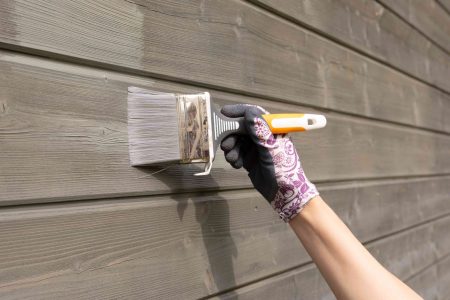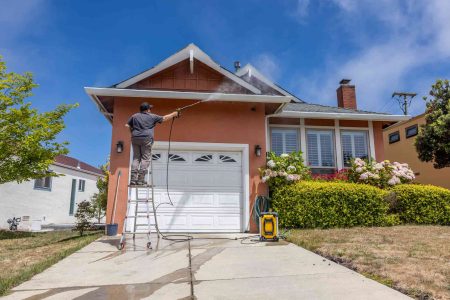Gutters repairs are necessary so your gutters can properly catch water runoff from your roof and channel it away from the foundation. It’s a simple, clean process but poorly functioning gutters that have leaking, misaligned, or broken parts allow water to pour off the side and pool up around the home. This is more than just an annoyance—the issue can create hydrostatic pressure in the soil, damaging your foundation. There are ways to make some DIY gutter repairs to fix simple problems.
Before You Begin
Keep in mind that you might not need all the tools and supplies listed here. You may be able to purchase a gutter repair kit that includes the specific parts you need along with the correct hardware. When searching for gutter parts, such as gutter fittings, gutter guards, and gutter hardware in a home improvement store, you will likely find them in the roofing department.
Below, learn how to fix gutters yourself and diagnose the most common problems like overflowing, sagging, leaking, clogs, improper slope, and loose downspouts.
Safety Considerations
When working on gutters, you will likely be on a ladder, sometimes a rather tall one. Take care to keep the ladder stable while you work. It’s always a good idea to have a partner helping you with a gutter project. While it can be an easy do-it-yourself job to handle gutters on the lower level of your home, if you have gutters on a second floor or higher, it’s best to call a professional to handle the work.
What You’ll Need
Equipment / Tools
- Ladder
- Bubble level
- Hammer
- Tin snips
- Garden hose
- Screwdrivers
- Cordless drill and drivers
Materials
- Plastic shims
- Downspout drop outlet
- Gutter sealant
- Gutter screws and/or nails
- Gutter/downspout straps
- Flashing material
- Gutter guard kit (optional)
- Fascia hanger brackets (optional)
- Roof and gutter repair tape (optional)
- Slip joints (optional)
- Retractable downspout (optional)
Instructions
How to Repair Gutters
-
Overflowing Gutters
Overflowing gutters can be caused by a simple clog, either in the downspout or in the center of the gutter. If water continues to pour over the edges after you’ve cleaned your gutters, they could be too small to handle heavy rains or improperly installed. First, determine where the extra water is pouring from. You can fix gutters that overflow by installing a diverter, a larger downspout, or a gutter apron depending on the source of the problem.
- If the corners are the problem, add a diverter that stands higher up than the top of the gutter’s surface. This will direct water evenly down the sides.
- If the gutter overflows above your downspouts during storms, your downspouts may be too small. Cut a larger hole in the gutter to accommodate a wider downspout, then attach it securely.
- Water can also overflow behind the gutter (against your house) if there is nothing in place to divert it from your roof to the desired area. Purchase gutter aprons in sections to install along the entire length of the gutter. This is a simple, effective fix that can instantly correct any drips behind your gutter.
-
Straighten a Sagging Gutter
Sagging gutters are out of level from the back to the front. You should be able to place a bubble level sideways across the gutter and have the bubble remain dead-center.
Sagging can be attributed to large amounts of water backing up and standing in the gutters. When this happens repeatedly over time, the gutter hangers will eventually loosen. Or wood fascia board rots and the fasteners do not hold as securely as before. This can cause your gutters to pull away from your house; simply hammer the gutter spikes back into place.
If they’re still sagging, you can repair a section of your gutters with a short-term, temporary fix:
- Wedge a series of plastic shims between the back of the gutter and the fascia board.
- Force the shims upward until the gutter levels out again.
- Tack the shims into place on the fascia board to prevent them from dropping down.
The long-term solution is to remove the gutter and rebuild the fascia board with a PVC board.
-
Tighten the Downspouts
Downspouts are the vertical sections of closed pipes that convey water from the gutters to the ground.
Downspouts that have loosened from the gutters are usually the result of missing or torn-out screws that are meant to attach the downspouts to the gutters. This is especially the case when, instead of using outlets, the installer cut out the gutter into flaps and attached the downspout to the flaps.
Downspouts, too, can become loosened from the side of the house. The two problems work in concert with each other: After the downspouts loosen from the gutters, they create stress and loosen the straps that secure the downspouts to the house.
Fix the problem using the following steps:
- Fit a downspout drop outlet into the gutter.
- Seal it with gutter sealant and screw it into place with gutter screws.
- Then, fit the downspout onto the outlet (from the bottom).
- Use screws to attach the downspout onto the outlet in at least two spots.
- Follow up by fixing the downspout against the side of the house with straps.
-
Seal Up Gutter Leaks
Gutter leaks are water leaks that happen over the side of the gutters, at the ends near end-caps or downspouts, or at some point along the length of the gutters. Separating gutter joints are gutters that are pulling apart at any of the seams; it could be along the run of the gutters or at inside or outside corners. Seamed gutters might be separating at the joints along the run. The following can help with seams, elbows, end caps, connectors, and holes:
- Seams: Repair gutter seams by adding new sealant to both sides of the seam.
- End caps: End caps can usually be tapped back into place and sealed with gutter sealant. Seamed or seamless gutters are prone to leaking at end caps and at elbows. Gutters may rust out if they are made of steel.
- Holes: All three types of gutter materials—steel, aluminum, and vinyl—can develop holes or cracks after being damaged. Even gutters that function on a basic level with small holes will have pronounced leakage when they are clogged. To patch a hole or small cracks in your gutter, use tin snips to cut out a patch from flashing material. Cement the patch into place with gutter sealant.
- Gutter slip connectors: They may have separated from the gutter itself. In some cases, you may be able to tap the gutter back into place from the end.
-
Clear Out Clogs
Clogged gutters have a blockage at any point in the run. This clog can be anywhere from the middle of the gutters down to the bottom of the downspouts. When water fills gutters, this overburdens the gutters and may lead to sagging.
Leaves or other debris may be clogging the gutters or downspouts. Straight gutter or downspout runs are less of a problem than downspout elbows. Any kind of turn is a prime area for clogging. You may also find debris clogging the end of the gutters at the hole leading down to the downspouts. Here’s how to clear clogs:
- Access the top of the gutter with a ladder to try to find the blockage. Use extreme caution when using a ladder for gutter work and have an assistant hold the ladder firmly against the house.
- If the block is around the access point to the drainpipe, remove the clog by running water from a hose down the downspout.
- If debris emerges from the bottom and water flows freely, you have cleared the clog.
- If the problem persists, disassemble the elbows from the downspout and clear them out individually with a hose.
-
Correct the Slope
Water standstill in gutters is a condition where the water no longer moves in the direction of the downspouts. In some cases, the water might even move backward.
If the water has not stopped flowing due to a clog, it’s usually because the slope is not adequate to move the water down to the downspout.
The gutters may have been improperly installed in the first place. Or the gutters might be loosening in one part of the run. If the fascia is failing, it can change the slope of the gutters. Take these steps:
- Remove the gutter and mounting brackets.
- When reinstalling them, adjust the gutter brackets by pushing the gutter to the proper pitch.
- Install the gutter so that the slope ranges from 1/8-inch to 1/2-inch vertical drop per 10 feet horizontal. A 1/4-inch drop is a safe average.
- Attach the brackets securely.
- If the fascia is in bad shape, you should replace it.
-
Install Gutter Guards for Consistent Clogs
Gutter guards are like strainers that you place over the top of your gutters. They work to stop the accumulation of small leaves and debris in your gutters that tends to block necessary water flow.
Guards are designed differently but they keep the debris from entering your gutters while letting water run through. Some guards are mesh, others are solid with a slit to let water through. Guards work on most standard gutters by fitting over the tops and attach with brackets.
-
Repair Broken Sections
There are a few broken parts of a gutter that are easy to replace. Consider the following:
- Spikes and fascia hanger brackets: Replace older warped spikes with fascia hanger brackets that help hang the gutters onto the house. Leave the spikes in place if possible to eliminate the hole that would be left if you took it out.
- Damaged section of seamless gutter: Replace a damaged or dented part of a seamless gutter with a slip joint to attach the parts.
- Downspout: Replace a battered downspout splash guard with a retractable downspout splash guard/block that you can roll up out of the way when mowing the lawn.
- Rust spots: Repair rusty spots inside the gutter with roof and gutter repair tape. It may take some extra adhesive product to secure the tape, but it will help your gutters to live a longer life.
When to Call a Professional
If you have a very tall house and your gutters are high up, it pays to hire a professional gutter installer to handle either fixing or replacing your gutters. Professional gutter installation for gutters with seams costs between $622 and $1,674, or $1,133 on average, but there are house size, material, and style factors (seamless vs. seamed) that will affect the cost. You’ll likely pay $3 to $5 per linear foot for vinyl gutters, $6 to $12 per linear foot for aluminum gutters, and $9 to $20 per linear foot for steel gutters. Seamless gutters will cost more.
How Often to Replace Gutters
Typically, you should replace your gutters about every 20 years. If your gutters have significant damage, they may require earlier replacement. Additionally, some gutters may last longer than 20 years when cared for properly.
Read the full article here














